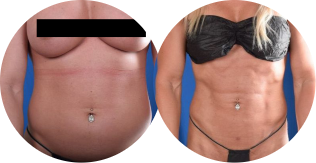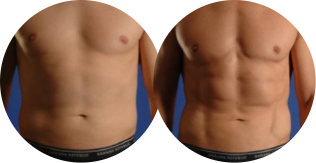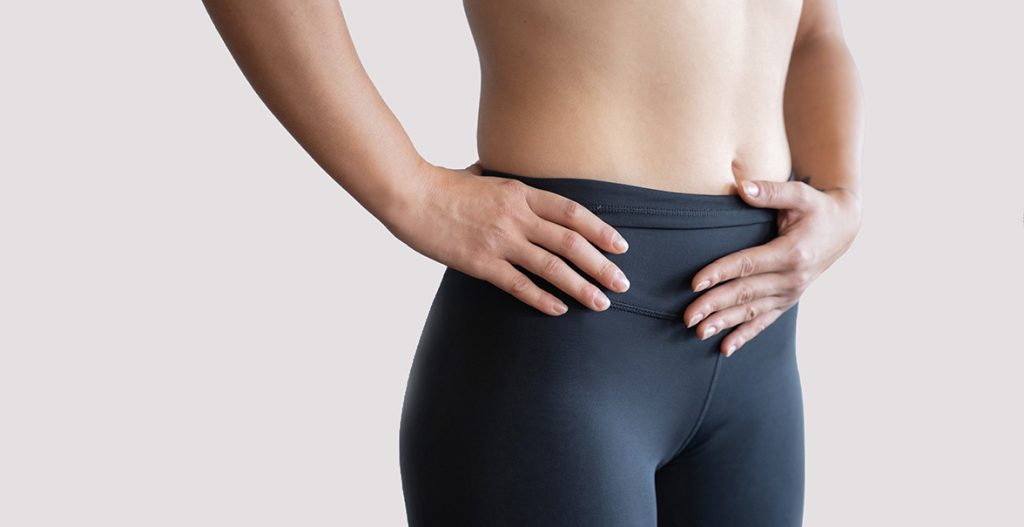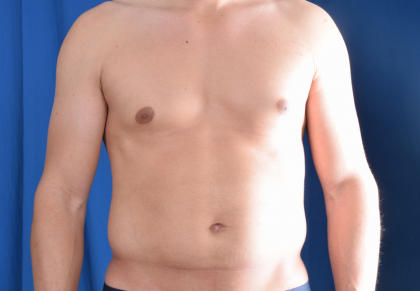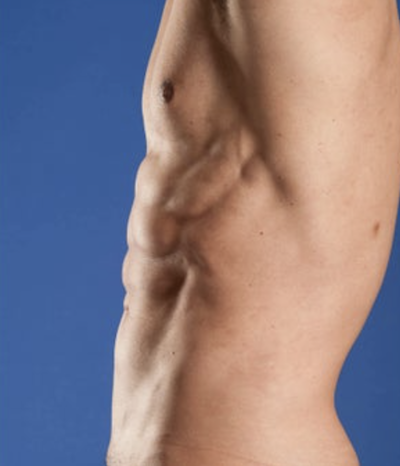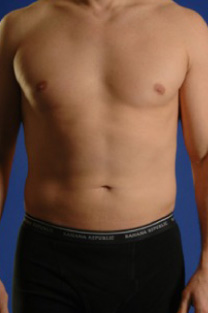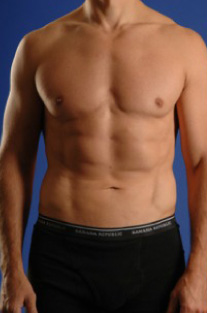VASER liposuction technology is widely used by plastic and cosmetic surgeons to extract unwanted fat. VASER Hi-Def is a specialized technique that enhances musculature definition in specific areas. Many surgeons use VASER to remove fat cells from various spots around your body, but only a few specially trained surgeons can achieve Hi-Def results. Hi-Def frees the fat cells that are stuck on top of muscle fibers. So, after a proper recovery, the skin rests naturally over the muscle directly, promoting a more muscular appearance.
When choosing VASER Hi-Def, it is vital to first factor in your body’s current composition and your desired aesthetic goals. We will assist you in doing just that during a private consultation. During your one-on-one at Millard Plastic Surgery, you will learn the differences between VASER and VASER Hi-Def. Dr. Millard is the pioneer of VASER HD Liposuction in the United States and the second to ever perform this procedure. We’ll help you determine which approach is best for you. If you would like to schedule a consultation, fill out this online contact form, and a member of our team will reach out to you shortly. If you would like to speak with one of our team members directly, call us at (303) 792-5665.
Before & After Photos
Before and After Photos
The Revolutionary VASER Technology
In the past few years, surgeons worldwide have improved the simple traditional liposuction procedure by inventing more advanced approaches that enhances results. VASER technology is the latest and greatest in these advanced approaches. Liposuction has long been surgeons’ go-to procedure to take away fat cells from areas like:
- Abdominals
- Flanks
- Legs
- Chest
- Bra line
- Butt
- Chin
- Arms
When we remove this fat, we accentuate the patient’s natural contours. VASER technology generates high-frequency ultrasound waves that vibrate fat cells loose from their connective tissues. These gentle waves make the fat cells easier to extract.
VASER vs. Traditional Liposuction
Since the 1970s, traditional liposuction has given countless patients their desired physiques. But this basic approach has at times produced underwhelming results. During a traditional liposuction procedure, a surgeon makes a baseline incision around that target area. Then, they insert a thin tube called a cannula into the patient’s subcutaneous tissue. This thin tube has a two-millimeter-sized hole on its end that suctions out fat cells. The surgeon moves this cannula back and forth around the target area, aspirating fat cells with each pass. Because the fat cells are stuck to connective tissue, multiple passes are needed to achieve desired results. But, more passes lead to more damage to the soft tissue structure. Fewer passes lead to underwhelming results. VASER technology was designed to avoid these pitfalls with safe, gentle ultrasound waves that allow for a less invasive procedure with optimized results.
Better Results
After we make the baseline incision in your target area, we insert the VASER cannula. This cannula emits the ultrasound waves into the subcutaneous tissue, causing only the fat cells to respond. The fat cells dislodge from the connective tissue. Because these fat cells are free from the sticky connective tissue, the VASER cannula picks up more with each pass. These high-frequency waves also affect the more superficial fat cells; the ones traditional liposuction is unable to reach. This advantage lets VASER liposuction produce better, more precisely sculpted results than other approaches.
Less Surgical Trauma & Quicker Recovery
VASER procedures are less involved than traditional approaches. Because fewer passes are needed with the cannula, there will be less surgical trauma, which results in no damage to the surrounding soft tissue structure. [2] So, you are free to return to your daily routine without the hassle of arduous and extensive recovery guidelines.
What Is VASER Hi-Def?
Now that we understand VASER technology it’s time to unpack the expert technique behind VASER Hi-Def. There are two forms of stored fat: visceral and subcutaneous. As the name implies, subcutaneous rests just under the skin and on top of the muscle. Visceral is deeper fat, centered around your internal organs, and is burned to keep the surrounding muscles energized.[3] VASER technology addresses the subcutaneous layer of fat by shaking the cells loose. This allows the surgeon to remove the subcutaneous layer and showcase the underlying muscles. But for patients wanting a high-definition appearance of chiseled muscled and a toned physique, VASER Hi-Def offers exciting potential.
VASER Hi-Def allows the surgeon to position the ultrasound cannula as close as they can to the muscle fibers, aspirating individual fat lobules from the area. Next, they take the cannula into the grooves of each muscle and around the musculature’s contours. When performed by a trained professional, VASER Hi-Def has been touted as the “overnight abs” procedure because of how effective it is at highlighting individual abdominal muscles. When applied to different areas like around the arms or under the chin, VASER Hi-Def pulls out a more detailed, natural definition from the treated area.
Which One Is Right For You?
When choosing which method is best for you, you need to consider the treated area(s) as well as the desired results. Traditional VASER is ideal for those interested in treating larger areas of the body for an overall slimmer, tighter physique. On the other hand, VASER Hi-Def deals in the details. This approach is best suited for showcasing more than just contours; it’s best suited to bring out your natural muscularity. VASER Hi-Def takes away the divisive layer of adipose tissue from between the skin and muscle, so your muscles’ definition is at the forefront of your physique.
Personal Consultation
If you think traditional VASER or VASER Hi-Def is right for you, please schedule a consultation at our offices. Since both of these procedures are surgically invasive, we will need to make sure you are fit enough for the procedure. This means if you smoke, we will ask that you stop before your procedure and during your recovery. Also, we only perform VASER on patients who reside at a healthy, stable weight. Your results will diminish if you gain weight after your VASER procedure.
During this consultation, we will also listen to any other aesthetic dilemmas you may have and recommend appropriate treatment options. VASER technology is easily implemented into many different body contouring procedures. If you have any other cosmetic concerns other than stubborn hard-to-lose fat, please mention them during this consultation.
Are Preparations Similar?
Before both procedures, we ask that you follow similar steps. First, we ask that you stop taking any blood-thinning medications a few days before your procedure. These will cause excessive bleeding during your treatment and slow down your body’s natural healing response. Next, we suggest scheduling a couple of days off from work. This will give you time to focus on rest and recovery, avoiding strenuous activities and heavy lifting. Also, designate a caregiver to look after you during the first couple of hours, post-op. We will include more personalized and comprehensive steps in your treatment plan.
VASER Procedure
Both procedures begin with anesthesia. Once it has taken effect, one of our surgeons makes a extremely small incision near your target area. The area is infiltrated with tumescent fluid, which becomes agitated by the ultrasound waves emitted by the VASER device to shake the fat free, and damage its cellular integrity. Once they have affected the desired amount of fat, they suction it out, carefully going along the edges of the muscle fibers. After they have completed your desired results, they suture the incision closed and move on to the next target area. Once they have treated each one of your cosmetic concerns, they will wrap the areas with a compression garment. These garments will be essential during your recovery because they improve swelling and aid in the body’s healing response. You are then free to return home and focus on rest and recovery.
After-Care
Once you’re home, it’ll be important to not disturb the treatment areas or compression wraps. We will examine these at your follow-up appointment. We also ask that you continue to avoid blood-thinning medications until your body has healed properly. Also, don’t lift heavy objects or participate in strenuous activities. After your procedure, you will notice the new contours almost instantly. Once the swelling and bruising subside, you will see your desired aesthetic results.
Non-Surgical Body Contouring
If you are interested in enhancing your VASER Hi-Def results, be sure to check out Emsculpt. Emsculpt is a wearable device that contracts muscle fibers 20,000 times during one 30-minute session. These contractions stimulate muscle growth. When paired with VASER Hi-Def, Emsculpt helps to define the muscles that VASER reveals.
What’s Does VASER & VASER Hi-Def Cost in Denver?
The cost of your VASER or VASER Hi-Def procedure will depend on your personalized treatment plan. We will go over the cost of your care during your consultation. If you would like to finance your treatment, check out our financing options by clicking here. To learn more about us, call our front desk at (303) 792-5665.
References
- Alfredo E. Hoyos, MD, John A. Millard, MD, VASER-Assisted High-Definition Liposculpture, Aesthetic Surgery Journal, Volume 27, Issue 6, November 2007, Pages 594–604, https://doi.org/10.1016/j.asj.2007.08.007
- Gibas-Dorna, M., Szulińska, M., Turkowski, P., Kupsz, J., Sowińska, A., Mikrut, K., Bernatek, M., & Piatek, J. (2017). The Effect of VASER Abdominal Liposuction on Metabolic Profile in Overweight Males. American journal of men’s health, 11(2), 284–293. The Effect of VASER Abdominal Liposuction on Metabolic Profile in Overweight Males – Magdalena Gibas-Dorna, Monika Szulińska, Piotr Turkowski, Justyna Kupsz, Anna Sowińska, Kinga Mikrut, Małgorzata Bernatek, Jacek Piatek, 2017
- Mittal B. (2019). Subcutaneous adipose tissue & visceral adipose tissue. The Indian journal of medical research, 149(5), 571–573. Indian Journal of Medical Research
